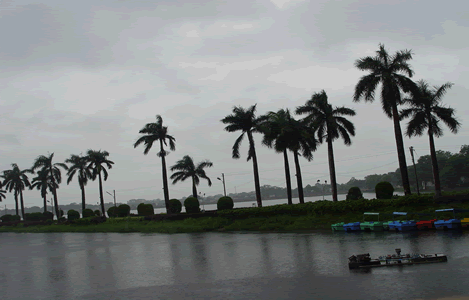|
Ruins, ponds & a college for princes

Photograph
by Preeti Verma Lal
When the
gods fitted their easel and pulled out their camel-hair brushes and started painting
Chattisgarh, they perhaps could only afford swatches of green and a little red.
How else could a place look so green - there's emerald green of the grass, the
rectangular green patches of paddy, the felled logs slanting on a dark green rug,
the thick green lotus leaves that blanket the ponds, there's the evergreen sal,
the moist teak…. For that dazzling contrast, there's the red of the tiled
roofs, the pink of the lotuses and the orange naked skin of the hill mynah. The
Muse sure must have struck the gods that moment. There's no other explanation
for such magnificence.
When
the gods fitted their easel and pulled out their camel-hair brushes and started
painting Chattisgarh, they perhaps could only afford swatches of green and a little
red. How else could a place look so green - there's emerald green of the grass,
the rectangular green patches of paddy, the felled logs slanting on a dark green
rug, the thick green lotus leaves that blanket the ponds, there's the evergreen
sal, the moist teak…. For that dazzling contrast, there's the red of the
tiled roofs, the pink of the lotuses and the orange naked skin of the hill mynah.
The Muse sure must have struck the gods that moment. There's no other explanation
for such magnificence.Chattisgarh was carved
out of big, fat Madhya Pradesh in November 2000. In its lap fell huge stretches
of sal forest, the last refuge of the hill mynahs, the precious iron ore, tin,
coal, diamond, bauxite and quartzite mines; several cement factories and power
plants. And of course, the Bhilai Steel Plant, which has seen no labour disputes
since its inception and individually, the plant has never dipped in the red. Its
capital Raipur that dates back to the 9th century proudly displays its glorious
past - the Town Hall, the Co-operative Building, the Bottle House, Raj Kumar College,
the Dudhahari Math, the 600-year old Budha Talab, the Qaser-e-Hind darwaza and
its rich history of trade in rice, minerals and spices. Raipur
that was once the capital of the Dakshina Kosala kingdom and later the seat of
power of the Haihaya dynasty, today sits in the heart of Chattisgarh. Also known
as the city of ponds (once there were 130 of them), Raipur played an important
role in the national movement and remains a center of education, rice trading
and religion. Traffic lights are manually operated by the cops in Raipur (there
are no orange lights, it is just green and red), but if you are looking for comfortable
lodging and great food, the town would not disappoint you. You can even find nachos
here! If you are in Raipur, spare a few days to roam around
its periphery and get pious a little. There are temples and more temples. Rajim
- the Prayag of Chattisgarh - has the 1,300-year old Rajiv Lochan Temple that
houses a rare idol of a barefoot Lord Vishnu and the pujaris here are Kshtriyas,
not Brahmins. Not too far in Sirpur is the country's only Lakshman Temple. Archaeologists
have recently unearthed a huge treasure trove of Buddhist temples in Sirpur. Champaran
owes its solemnity to Saint Vallabhacharya, the founder of Vallabh sect, who was
born in this sleepy town in the 15th century. But no talk of temples in Chattisgarh
would be complete without mentioning the erotic sculptures in the 11th century
Bhoramdeo Temple. If you into music and other performing
arts, spend a day in Khairagarh, it is Asia's only university dedicated solely
to performing and visual arts. When in Chattisgarh, plan
a separate itinerary for the south, for that's where beautiful Bastar is. Nature
has been immensely kind to Bastar - it has beautiful sal forests, Kanger Valley
is the last refuge of the hill mynah, there's the Chitrakote falls, the stalactite
caves in Kotamsar, the Danteswari temple… And yes, the lovely tribal women,
the now-famous bell metal handicraft and the rare railly wild silk. So much to
see that days would hurry past and you would still sigh at all that you could
not touch. Before you pack your bags and bid adieu to
Chattisgarh, remember to have the salfi (if you want to get drunk wait for the
sun rays to peep into the earthen pot), the red ant chutney and at least one of
the 23,000 varieties of rice that grows on its belly. P.S:
Having done with the greens, the pinks and the reds, as an afterthought the gods
borrowed some glitter from the neighbor and added the diamond mines in Chattisgarh.
Go there, the gurgle of the hill mynah, the exquisiteness of the tribal women,
the mystery of the stalactite mines and the sheen of the diamond might take your
breath away. I don't know about you but I would not mind dying in such a gorgeous
patch of earth.
Published
in Discover India magazine, September 2004. |

